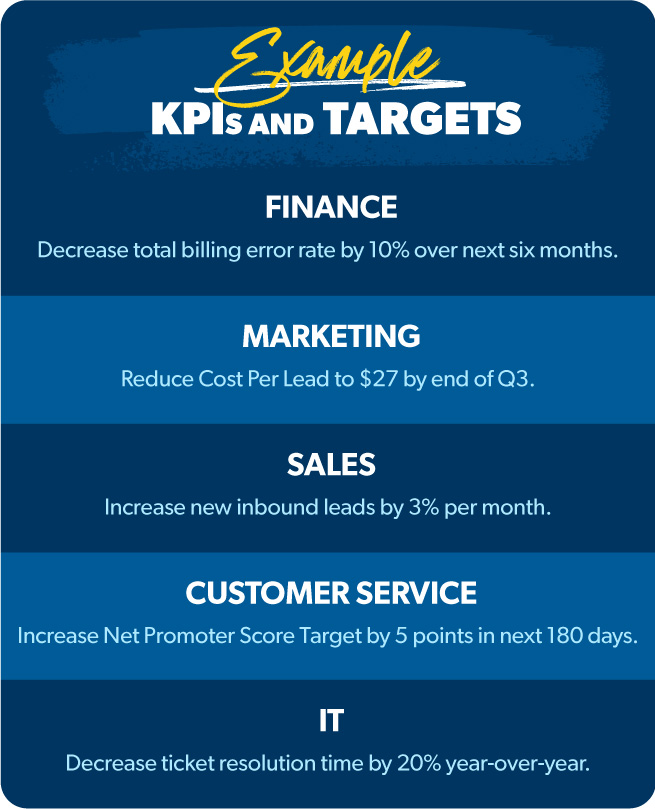
No one wins the Super Bowl by accident. It’s the same in business. To taste real victory, you have to set the right goals, track your progress, and work your butt off. You also need to make adjustments as you go to stay on target. Enter the KPI. And what does KPI stand for? Key Performance Indicator—aka your guide to understanding all the moving parts of your business in real time.
KPI isn’t just a buzzword you throw around, hoping to sound like you’re killing it. A KPI is a measurable metric that shows if, and how effectively, your company is hitting its operational and strategic goals. KPIs are the most important part of your company scorecard, flash report or dashboard. They shine a light on all levels of your business so you get a clear picture of how well you’re performing overall or by department, project or team.
KPIs are especially important when we’re talking about goals that take a ton of freakin’ work and time to accomplish. KPIs tell you when to course-correct, customize, accelerate or pull back to increase your chances of making that Super Bowl win.
Why Are KPIs Important?
The great motivational speaker Zig Ziglar said it best: “If you aim at nothing, you’ll hit it every time.” If your business is operating with weak KPIs or none at all, it’s like hiking with a broken or missing compass—in the middle of the night. But with the right KPIs in place, the upside for your business is enormous.
- KPIs can track everything from efficiency and compliance to profit, sales leads, customer satisfaction and so much more.
- KPIs put laser focus on where you can move the needle to achieve your goals. You see in real time which business areas are crushing it and which areas need attention. Hello, better decision-making!
- KPIs help unify your team around a purpose and measure they are accountable to. Working in sync leads to higher team engagement, performance and productivity. When it comes to confusing strategies and goals-gone-rogue, you’ll be singing, “Baby, bye, bye, bye.” (Thanks, ‘N Sync.)
Related articles:
Your Guide to Strategic Planning That Boosts Your Business
Product Launch: 10 Questions to Ask Before You Launch a New Product
New Product Launch: Your 10-Step Checklist
Your Road Map to Grow Your Business
Dave Ramsey’s new book Build a Business You Love is now available for purchase! This book will walk you through the same proven system Dave Ramsey used to build Ramsey Solutions from a card table in his living room to a $250 million company.
Types of KPIs
If you assume KPIs are always numbers, always tied to the future, or always bound to the strategic side of your company, think again. Let’s look at a few types of KPIs to get a true picture of how they might work in your business:
- Quantitative – These indicators are measured solely by a number, such as how many minutes a customer was on hold or the number of customer complaints received in a week.
- Qualitative – These indicators are based on opinion, experience or feelings that represent the individual value we place on a process, service or business decision. (For example, you can measure customer satisfaction or service experience KPIs through a fill-in-the-blank opinion survey or a focus group.)
- Leading – These indicators are tied to foresight that help predict the outcome of a change, like the number of leads in a sales funnel.
- Lagging – These indicators measure what’s already happened, like revenue. (Tip: You’ll want to use a mix of both leading and lagging KPIs to make sure you’re tracking what’s most important.)
- Strategic – These indicators monitor your company’s big-picture goals, such as revenue or return on investment.
- Operational – These indicators measure shorter terms and organizational processes, like cost per acquisition.
- Functional – These indicators are classified as strategic or operational but are tied to specific functions of a business. (For example, a functional finance KPI might track gross profit margin.)
KPI Examples for Different Business Departments and Functions
If your head is spinning a little, we get it. Sometimes words sound great in the boardroom but don’t mean much until you see them in action. So, let’s look at some common KPI examples used in business.
Finance
- Common KPIs Measured: Gross Profit Margin, Net Profit Margin, Operating Profit Margin and Expense Ratio, Billing Error Rate, etc.
- Example KPI and Target: Decrease total Billing Error Rate by 10% over the next six months.
Marketing
- Common KPIs Measured: Marketing Qualified Leads, Conversion Rates, Return on Ad Spend
- Example KPI and Target: Reduce Cost Per Lead to $27 by the end of Q3.
Sales
- Common KPIs Measured: New Inbound Leads, Average Order Value, Total Pipeline Value, New Qualified OpportunitiesExample KPI and Target: Increase new inbound leads by 3% per month.
Customer Service
- Common KPIs Measured: First Contact Resolution Rate, Average Response Time, Customer Satisfaction Score, Average Customer On-Hold Time, Calls Handled Per Hour
- Example KPI and Target: Increase Net Promoter Score target by five points in the next 180 days.
IT
- Common KPIs Measured: Total support tickets (open, resolved, reopened), ticket resolution time
- Example KPI and Target: Decrease ticket resolution time by 20% year-over-year.
Related article: Top Weekly Reports and the One You Can’t Live Without
Wait. What’s the Difference Between KPIs and Metrics?
If you can’t measure it, you can’t improve it, right? But if metrics and KPIs are both measurements, what gives? The words metrics and KPIs are often used interchangeably. But the truth is, they’re not the same. Metrics inform KPIs. Here’s a description of each to help you make sense of the differences.
Metrics
- May or may not be useful to overall business objectives
- Provide a single quantifiable measurement
- Often follow an industry benchmark or historical internal metrics
- Look at specific processes or activities, like the number of PDF downloads or site visits
- Can exist without a target or performance measure, and the goal doesn’t have to be to improve something
Metric Examples
- Number of sales calls each quarter
- Share of impressions on your digital ad or web page
- Total clicks on your ad or web page
KPIs
- Are key to overall objectives and to focusing your team on what’s most important
- May involve several metrics
- Align with objectives specific to your company
- Are laser-focused on progress toward trackable key objectives
- Need a quantifiable target value
- Indicate performance and eventually become insights that direct your strategy and decisions
KPI Example
- Sales conversion rate with target to increase 10% by the end of Q4 (Your KPI should be based on the metrics that guide how you adjust to hit your target.)
How Do I Define My KPIs?
Now that you know what a KPI is, why it’s important, and common types and examples, you’re ready to develop your own. As you exercise this muscle more and more, creating KPIs will become a keystone habit that’s second nature to you.
You probably thought running a business sounded fun—until you realized it would actually run you. Discover the EntreLeadership System—the small-business road map that takes the guesswork out of growth.
Answer these important questions as you choose KPIs for your business:
- What problem are you trying to solve?
- What’s your desired outcome?
- Why does this outcome matter?
- How will you measure progress?
- How can you influence the outcome?
- How will you know if you’ve successfully achieved the outcome?
- How often will you review progress toward the outcome?
Let’s say your objective is to increase qualified sales leads. The answers to those questions might look like this:
- Our problem is that our pool of qualified leads is drying up.
- Our desired outcome is to get more qualified sales leads in the next 60 days.
- Achieving this objective will increase profits.
- We’ll measure progress by the number of sales leads generated by our new marketing campaign.
- We can influence the outcome by executing a highly targeted email marketing campaign.
- We’ll know we succeeded if qualified sales leads increase by 7% by end of Q3. (This is where you really nail down your KPI.)
- We’ll review progress weekly for a nine-week period.
Here’s how you might put these goals, KPIs, targets and metrics together:
- The company goal is to increase overall sales by 3% by the end of the fiscal year.
- The sales team KPI is to increase Sales Qualified Leads (SQL).
- The target is a 7% increase by the end of Q3.
- The metrics are the number of emails sent weekly, open rates, click rates and unsubscribes.
As you develop your KPI and target, think about the nitty-gritty and be sure to include these five elements to set business goals that really work.
- Be specific – Is your goal clearly defined? What’s your target, and how will your KPI be used to track it?
- Make it measurable – Can you easily track and measure progress for this KPI? What strategic or operational goals are they tied to?
- Make it time-sensitive – What’s the time frame? How long will you focus on the KPI?
- Make it yours – Will this KPI help you achieve your goals for your business? Is it relevant to you?
- Put it in writing – Did you write down a blueprint for this KPI? What will it take to put the KPI in place and track progress?
Got It. Now, How Can I Get My Team’s Buy-In on KPIs?
Before we get to that important question, let’s pause for a quick quiz. (Hang with us . . . There’s a point, we promise!)
Question: What do these three things have in common?
- That fine china you got for your wedding
- The consolation souvenir T-shirt your mom gave you because you couldn’t join the family vacation
- Sketchy GPS instructions
Answer: Nobody uses them.
The last thing you want to do is add your carefully created KPIs to the Things Nobody on My Team Uses category.
If you give KPIs to the right people, your company will be a force to be reckoned with. And the right people should mean everyone on your team. That means getting your whole team on board. Here’s how:
- Teach your team the basics on KPIs—including how to understand and use them.
- Communicate important KPIs to your company. You’re relying on your team to carry out the work. Help them win by making sure they understand the goals, KPIs and targets.
- Don’t forget your how and why. If you want a team as devoted as your best friend Fluffy, take the time to share how you’re measuring progress and why it matters to the big picture of your business.
How Often Do I Need to Measure and Use a KPI?
The whole point of setting KPIs is to track progress and stay on target. And just like your business shouldn’t become static, your KPIs need to evolve and change with your company objectives. Otherwise, you’re in danger of blindly driving toward goals you can’t achieve—or outcomes that aren’t relevant when you get there.
Review your KPIs regularly (weekly is ideal—do it monthly at minimum) to know when and how to fine-tune them. Keep track of them and look at your historical trends over the last quarter and year to see how effective your tactics are. If you discover they’re not useful anymore, get rid of them! You want new and better KPIs that align with your business anyway.
Remember, you might not get it right the first time. KPIs are never perfect. You’ll learn what’s useful and what’s not as you go and can dial in your indicators over time. It’s also worth noting: Don’t try to measure everything. Choose only the most important things that will tell you whether you’re on track to win.
What's Next
Now it’s time to go for it! Once you know what you’re aiming at, how to communicate and track it, and when to review your KPIs, you’ll be ready to make a run at becoming the Super Bowl-level champ of your business sector.
Looking for even more practical business and leadership tools? Listen to the EntreLeadership podcast. While you’re at it, subscribe to the podcast and hear from today’s top business and personal growth experts.

